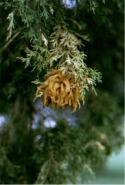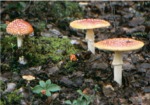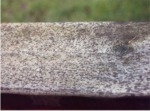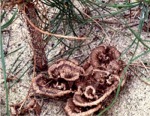|
|
|||
| Assess and explain aspects of fungi as they may be related to issues encountered by manufacturers, attorneys, builders, government agencies, retailers, homeowners and other public or private entities: | ||||
|
|
||||
|
|
How fungi cause different types of decay: | Example 3 Example 4 | ||
|
|
Formation and impact of mycorrhizal relationships: | Example 1 Example 9 |
|
|
|
|
Impact and role of alternate hosts in rust fungi: | Example 5 | ||
|
|
Spore discharge and distribution of fungi: | Example 6 | ||
|
|
Nutritional and environmental impacts on mildew: | Example 2 | ||
|
|
||||
|
|||||||
 |
|
Example 5: Juniper tree infected with cedar apple
rust. Innocuous disease caused by spores from apple trees in
neighborhood. Gymnosporangium juniperi-virginianae |
 |
||||
|
|
|||||||
|
Example 6: American elm infected by
|
|||||||
|
|||||||
| Interpret and explain the significance of mycological phenomena such as fairy rings, slime mold appearance, plant diseases and mycorrhizal associations. | |||||||
 |
|
|
 |
||||
| Example 7 | Example 8 | Example 9 | Example 10 | ||||
| Agaricus bitorquis causes a fairy ring by growing out in all directions from the original inoculum in the grass. The grass will recover and turn green. |
Black knot of cherry caused by Apiosporina morbosa. It is unsightly but largely innocuous |
Mycorrhizal association between pine seedling and Thelephora
terestris -- necessary association for vigorous growth of trees. |
Fuligo septica (a slime mold sometimes called The Blob) is frequently found in wood chip mulch. It lives on bacteria and other surface contaminants and is not dangerous to humans. | ||||







